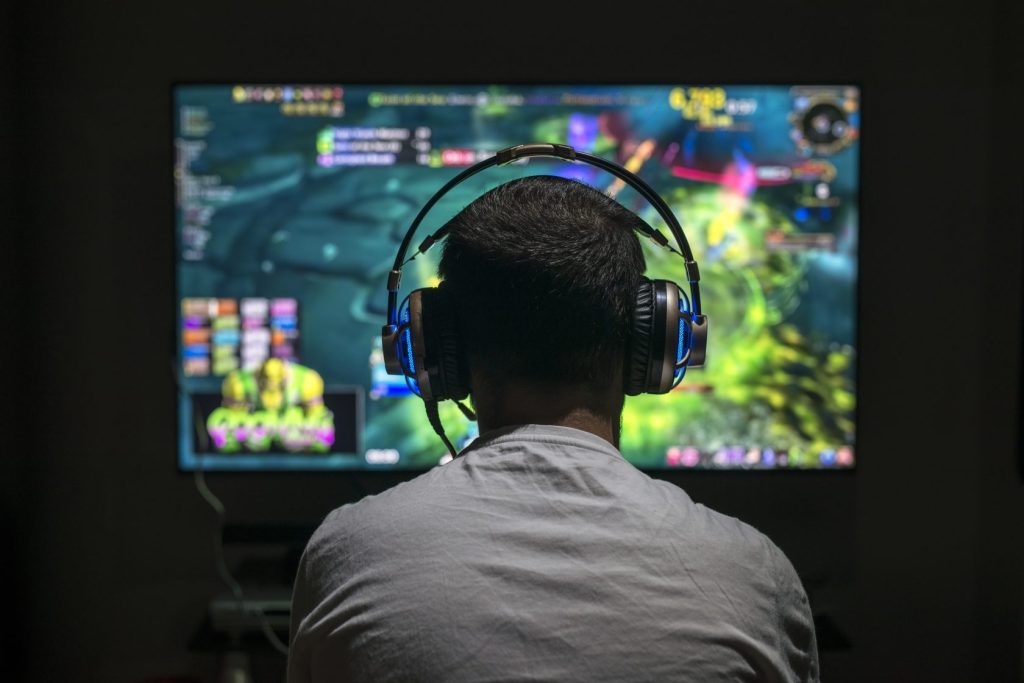Depending on your gaming type, you may find yourself with specific needs from your headset. For instance, FPS shooters require precise locations of footsteps and enemy fire to calculate their position. This may not seem like a concern for casual gamers, but for those looking to play competitive games, even on a casual level, good audio will improve your experience.
Headsets vs. Headphones
There is a rather consistent debate on whether gamers should use gaming headsets or traditional headphones with a standalone mic. We’ve covered this topic in fair detail already, so we won’t go too deep into it.
In summary, if you’re looking for the best possible sound quality and microphone quality, opting for a dedicated standalone microphone and a good pair of traditional headphones will give you that. However, this configuration doesn’t work for everyone, and those with limited desk space or who do not want to have the hassle of additional cables may still opt for a gaming headset.

Comfort Is Important For Long Periods Of Use
Comfort is one of the most important factors when choosing a gaming headset. We gamers can spend hours on end with our headsets on, and many of us don’t take them off until we leave the computer, whether gaming or not.
If I’ve learned one thing over the years of gaming on headphones, it’s to make sure I am happy with the comfort level of my headset. Having moved between several different brands and models, it was always hit and miss. The best way to avoid this is to look for headphones that are notably comfortable across the board for all different head sizes.
Certain headset designs may compress the ears too much or feel too heavy for your head. Thankfully, online reviews have made finding which models tend to have issues with their fit very easy. I recommend scouting online reviews for an aggregate of comfort for any headset you buy.
Consider Your Cable Length
Comfort isn’t just tied to how a gaming headset fits on your head. The length of the cable can impact your seating position, cause neck tilting, and decrease your ability to move around at your desk. Think about the placement of your computer case in relation to your seating position, and make sure you have some extra cable length available.
If your case is on the right side of your desk (for right-handed gamers) or on the floor, you’d need more cable length than you would if your case was on the left side (depending on the exact distance). We recommend opting for a 3-meter cable for cases further away from the seating area, though 2.5m will sometimes suffice. If your case sits to the left of you, you can probably get away with less, but I’d still suggest going for something around 2.5m.
Noise Isolation
Noise isolation is another factor to consider when choosing a gaming headset. If you’re playing in a noisy environment, you’ll want a headset to block out external noise, allowing you to focus on the game. Look for headsets with closed-back ear cups to help block out external noise. Some headsets also come with noise-canceling technology, which can help further reduce external noise. When it comes to noise cancellation, there are several techniques used:
Passive Noise Cancellation is achieved through appropriate materials used to provide a tight seal around the listener’s ear, while Active Noise Cancellation uses microphones to phase-cancel unwanted sounds. For most gaming uses, passive noise cancellation should do the trick.
With that said, ANC is still a relatively rare feature on most gaming headsets and is more commonly found on consumer headphones. So you’ll find the most ANC options if you opt with a headphone and independent microphone combination. However, you’ll still be able to find dedicated gaming headsets that offer this feature.
The Onboard Microphone
While a microphone isn’t necessary for single-player games, if you are a multiplayer gamer and need to communicate with others on your team, having a microphone is essential, and making sure it sounds good is also vital. It’s somewhat mandatory in the online gaming space to rag on the guy with the bad microphone in the lobbies. No one wants to be that guy…
Thankfully, there are a lot of dedicated gaming headsets out there that offer excellent microphone quality. The quality typically won’t match that of a dedicated desktop condenser microphone. Still, it will be enough to keep you from sounding like the classic memes around Call of Duty lobbies.
Some gaming headsets utilize removable microphones, so you can replace the microphone after a few years if it has problems. While these work, in my experience, by the time the microphone dies, the headset model has been replaced by a new version, and the older mics are a little harder to find. Yet, they still hold merit.
Open-Backs vs. Closed-Backs
There are two primary designs of headphones: closed-back and open-back. Open-back headphones allow air to escape from the earcup in the opposite direction of the ear instead of bouncing all the sound within the earcup. The result is that open-back headphones provide more soundstage, a feeling of wider sound. Open-back headphones traditionally perform less aggressively in their bass response, though.
Closed-backs, conversely, confine sound vibrations so that the soundstage is narrower and more directly focused toward your ear. While this style reduces soundstage, it increases bass response.
Historically, gamers tended to opt for closed-back headphones, but in recent years, we’ve seen far more open-back headphones get adopted, especially from Sennheiser. This is especially true for gamers who also have a passion for music and audio and who want to experience a more immersive and wide listening experience.
If you’re unsure which one is right for you, we’ve covered the topic of open-back and closed-back headphones in much more depth.
Wired vs. Wireless
The debate between wired vs. wireless has been raging in gaming for over a decade. Up until the mid-2010s, wireless technology was not great for gaming. Battery technology lacked efficacy, and wireless speeds were limited by physical technologies and the lack of efficient codecs (at least in comparison to today’s wireless devices).
These days, wireless devices, including headsets, have become far more reliable in the gaming space. We’ve seen lots of reductions in latency with newer technology like aptX, bringing with it a whole new experience when it comes to latency on wireless devices.
Whether or not you should go wireless or wired is now more of a personal choice than an objective right or wrong. The biggest challenge with wireless headsets is the charging it requires. With time, you will form a charging habit, but in the beginning stages of wireless adoption, it’s common to forget to charge your headset, which is never a fun experience.

Console or PC?
Don’t worry. We’re not going to get into this topic too deeply. However, there are specific headsets targeted toward specific consoles. This is usually done by changing the primary jack that is used on the headset. For computers, you’ll find that USB-A or 3.5mm aux is the most common connection type. You’ll find the same for PlayStation and Xbox users, with some plugging into the controller with an aux while others connect directly to the console. Nintendo Switch and mobile phone headsets will usually feature a USB-C connection instead.
In most cases, these headsets can be used across all other platforms that share their connection type. For instance, you could easily use a USB-A PlayStation headset on a computer. But if you were to use a Switch headset, you’d need a USB-C to USB-A adapter.
Budget
Set yourself a realistic budget for a gaming headset. Your price point will have a lot of influence on what you can get. For single-player gamers, we’d recommend getting a dedicated traditional headphone without a microphone – this will typically set you back between $50 and $200, depending on the quality you’re looking for. If you plan to listen to music with your headphones, we recommend going for something like the Philips Fidelio X2HR, which is around $150.
For multiplayer gamers who play casually with friends – dedicated gaming headsets will offer you the easiest solution, and it doesn’t always cost a lot of money either. We’d also recommend spending around $100 for a decent pair of gaming headphones that can cater to casual music listening and gaming if you’re more audio-centric and want good-quality sound.
If you play games competitively in the multiplayer space, particularly in FPS games like Valorant, Counter-Strike, or Apex Legends, you’re going to want headphones that can give you good detail of enemy position, so a focus on good directional sound is essential. We also recommend opting for a standalone condenser microphone to pair with it. Expect to pay a bit more, but some great microphones on the market don’t cost much, and a good pair of headphones may set you back around $150-$200, but they can last you for many years and have enough versatility to be carried with you even if you stop gaming.





